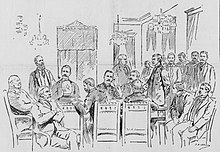

Charles T. Gulick
Quick Facts
Biography
Charles Thomas Gulick (July 25, 1841 – November 7, 1897) was a politician in the Kingdom of Hawaii. He was one of the few members of the various missionary families of the time to side with the monarchy in the 1893 overthrow of the Kingdom of Hawaii.
Life
Gulick was born in July 25, 1841 to a family of American missionaries. His father was William Gulick, and mother was Eliza Throop Thomas (1804-1903). His father's brother Peter Johnson Gulick married his mother's sister Frances "Fanny" Hinckley Thomas (1798-1883), who had seven children (his cousins) who also became missionaries, including Luther Halsey Gulick (1828-1891) and John Thomas Gulick (1832-1923).
He attended Punahou School 1855-1862, where he was a pitcher on a team called the "Pacifics" playing early games of baseball with the sons of Alexander Cartwright. In September 1869 he officially became a citizen of the Kingdom of Hawaii. He ran a business as notary public and issued government documents such as marriage licenses. He joined the Honolulu Rifles militia, with rank of Captain, and later served as adjutant general. On February 5, 1876 he married Sarepta A. Thompson in Honolulu.
He was appointed to the cabinet of King Kalākaua as Minister of the Interior on August 6, 1883, and served until June 30, 1886. It is widely thought that sugar magnate Claus Spreckles had suggested both changes.:268 Both before and after Gulick, Walter M. Gibson acted as Minister of the Interior, while also acting as minister of Foreign Affairs and even attorney general. He went back into business, and became a real estate broker.
Gulick was appointed again to the post of Minister of the Interior of Queen Liliʻuokalani on September 12, 1892 and served until November 1, 1892.

He met with Liliʻuokalani other leaders loyal to her on January 15, 1893, just before the overthrow of the Kingdom of Hawaii. :590 In the 1895 Counter-Revolution in Hawaii he was tentatively selected to be Minister of Finance in the cabinet, and drafted the new constitution to be used if the plot had succeeded. He and the other leaders were arrested, and put on trial for treason starting January 21, 1895. The defence was led by former attorney general Paul Neumann.:209–210 Although Gulick denied involvement in plans for military strikes, witnesses testified the group met at his house. He was convicted and first sentenced to death, which on February 23 was reduced to 35 years in prison and a fine.:214
Gulick was part of the last batch of prisoners to be released when the remaining eight prisoners including him and Wilcox were pardoned and released on January 1, 1896. He died November 7, 1897. A street was named Gulick Avenue for him in Honolulu, at 21°20′11″N 157°52′27″W / 21.33639°N 157.87417°W.
His mother lived to almost 100 years and died August 27, 1903.